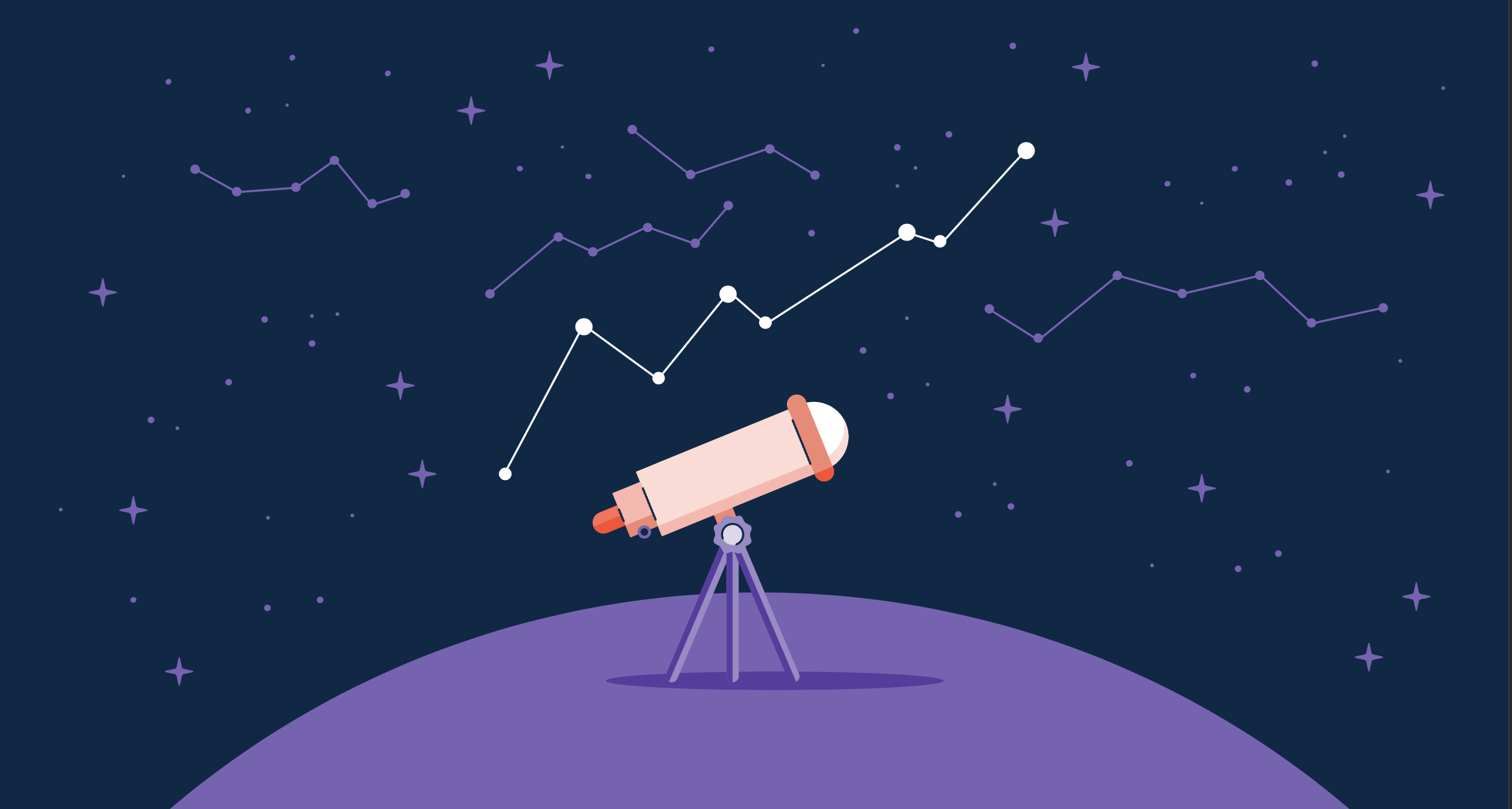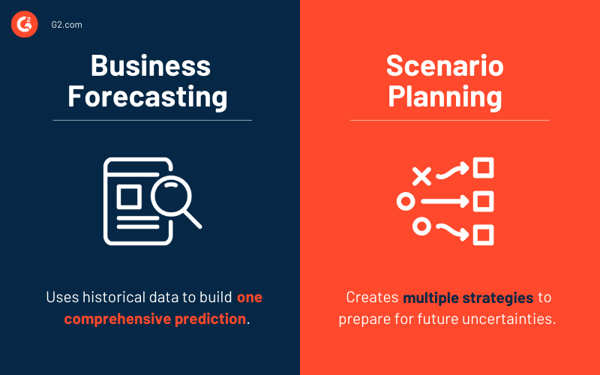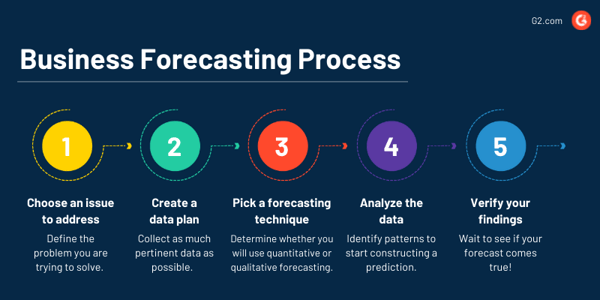November 29, 2021
 by Alexandra Vazquez / November 29, 2021
by Alexandra Vazquez / November 29, 2021

It’s time to look inside your crystal ball and start forecasting.
Forecasting gives you the tools you need to make reliable predictions about foreseeable events.
Business forecasting is the process of analyzing data to predict future company needs and make insight-driven development decisions.
There’s really no downside to being prepared! Building a strong forecast prepares businesses for potential issues and identifies areas for profitable growth. Even if your predictions end up being inaccurate, you’ll have all the necessary data and information to get closer to the final forecast.
Some companies utilize predictive analytics software to collect and analyze the data necessary to make an accurate business forecast. Predictive analytics solutions give you the tools to store data, organize information into comprehensive datasets, develop predictive models to forecast business opportunities, adapt datasets to data changes, and allow import/export from other data channels.
Businesses can create various types of forecasts with business forecasting strategies. Because historical data and market trends affect so many aspects of business, comprehensive predictions can help prepare almost every element of your company.
There are two main types of business forecasting methods: quantitative and qualitative. While both have unique approaches, they’re similar in their goals and the information used to make predictions – company data and market knowledge.
The quantitative forecasting method relies on historical data to predict future needs and trends. The data can be from your own company, market activity, or both. It focuses on cold, hard numbers that can show clear courses of change and action. This method is beneficial for companies that have an extensive amount of data at their disposal.
There are four quantitative forecasting methods:
The qualitative forecasting method relies on the input of those who influence your company’s success. This includes your target customer base and even your leadership team. This method is beneficial for companies that don’t have enough complex data to conduct a quantitative forecast.
There are two approaches to qualitative forecasting:
There are several benefits to making effective forecasts for your business. You gain valuable insights into its different aspects and the future of its success.
While the benefits of business forecasting highlight all of the amazing advantages it has to offer, it’s not a surefire way to prepare for the future. Companies who plan to forecast should also keep the challenges in mind and make sure that forecasting has more pros than cons for their business. Below are some of the notable challenges of business forecasting.
Business forecasting is often confused with scenario planning because of their shared goal of preparing for the future. Both rely on learning from past mistakes and reflecting on what decisions must be made to drive success. However, business forecasting and scenario planning differ in the preparation process.

Business forecasting focuses on a problem at hand and uses historical data to predict what might happen next. It emphasizes predictive analytics and the need to eliminate existing uncertainties. The problem can be as broad as the actual performance of the entire company, or as specific as how a single product might sell in the future based on past market trends.
While built on tangible data, forecasting is essentially a guess of the future and you need to make assumptions ahead of time to prepare for any predicted issues. Forecasting is an all-hands-on-deck approach that involves many departments, including analysts, economists, managers, and more.
Scenario planning creates multiple scenarios to help prepare for the future. With these scenarios in mind, a company can begin planning a course of action to achieve the desired outcome. This includes creating step-by-step strategies and timelines for achieving objectives.
While business forecasting focuses on past information, scenario planning takes the past, present, and future into consideration with learnings from the past, understanding the capabilities of the present, and aspiring for future success. Although a team’s input is important in scenario planning, company’s primary decision-makers carry out the bulk of the process.
The way a company forecasts is always unique to its needs and resources, but the primary forecasting process can be summed up in five steps. These steps outline how business forecasting starts with a problem and ends with not only a solution but valuable learnings.

The first step in predicting the future is choosing the problem you’re trying to solve or the question you’re trying to answer. This can be as simple as determining whether your audience will be interested in a new product your company is developing. Because this step doesn’t yet involve any data, it relies on internal considerations and decisions to define the problem at hand.
The next step in forecasting is to collect as much data as possible and decide how to use it. This may require digging up some extensive historical company data and examining the past and present market trends. Suppose your company is trying to launch a new product. In this case, the gathered data can be a culmination of the performance of your previous product and the current performance of similar competing products in the target market.
After collecting the necessary data, it’s time to choose a business forecasting technique that works with the available resources and the type of prediction. All the forecasting models are effective and get you on the right track, but one may be more favorable than others in creating a unique, comprehensive forecast.
For example, if you have extensive data on hand, quantitative forecasting is ideal for interpretation. Qualitative forecasting is best if you have less hard data available and are willing to invest in extensive market research.
Once the ball starts rolling, you can begin identifying patterns in the past and predict the probability of their repetition. This information will help your company’s decision-makers determine what to do beforehand to prepare for the predicted scenarios.
The end of business forecasting is simple. You wait to see if what you predicted actually happens. This step is especially important in determining not only the success of your forecast but also the effectiveness of the entire process. Having done some forecasting, you can compare the present experience with these forecasts to identify potential areas for growth.
When in doubt, never throw away “old” data. The final information of one forecasting process can also be used as the past data for another forecast. It’s like a life cycle of business development predictions.
With the different types of business forecasting come different potential use cases. A company may choose to utilize several elements of business forecasting to prepare for various situations. Here are some real-life examples where business forecasting would be valuable.
Suppose you represent a company that has been in the market for a long time but has never tried business forecasting. Because of the long history of company data, you choose to try out quantitative business forecasting. Your aim is to make predictions using the most cost-effective and least time-consuming method. With those considerations, you may opt for the trend series method to manually identify common trends in old data, determine the likelihood of repeat instances, and forecast accordingly.
Imagine you are a new company that has entered the market to start selling your own brand of smartphones. You may think that business forecasting is impossible because you don’t have any historical company data to work off of. However, you can utilize qualitative business forecasting! Because the smartphone industry is a highly competitive one, you can use market research to take advantage of publicly available market data.
Imagine you work for a recruiting company that has noticed that the country’s unemployment rate heavily affects company performance and has the data to prove it. As you have a clear indicator that directly impacts the potential for success, using the indicator approach to create long-term predictions would be the right call.
However, your company stresses the importance of integrating expert knowledge into the forecasting process. This extra note means that some qualitative forecasting can be used as well. You may choose to use the Delphi method to collect expert opinions and weigh that into the final forecasts as well.
Creating comprehensive predictions isn’t rocket science. With business forecasting, seeing the future is as easy as learning from the past. What you do with your findings is what will set you apart.
Want to start forecasting for your business? Learn more about business analytics and how it helps collect the necessary data and insights.
Alexandra Vazquez is a former Senior Content Marketing Specialist at G2. She received her Business Administration degree from Florida International University and is a published playwright. Alexandra's expertise lies in copywriting for the G2 Tea newsletter, interviewing experts in the Industry Insights blog and video series, and leading our internal thought leadership blog series, G2 Voices. In her spare time, she enjoys collecting board games, playing karaoke, and watching trashy reality TV.
The quest to understand customer behaviors spans decades.
 by Danylo Kriukov
by Danylo Kriukov
With worldwide retail e-commerce sales projected to increase, the industry is booming without...
 by Bamidele Onibalusi
by Bamidele Onibalusi
If you run a restaurant or retail store, you need a POS system to function.
 by Lauren Fram
by Lauren Fram
The quest to understand customer behaviors spans decades.
 by Danylo Kriukov
by Danylo Kriukov
With worldwide retail e-commerce sales projected to increase, the industry is booming without...
 by Bamidele Onibalusi
by Bamidele Onibalusi


